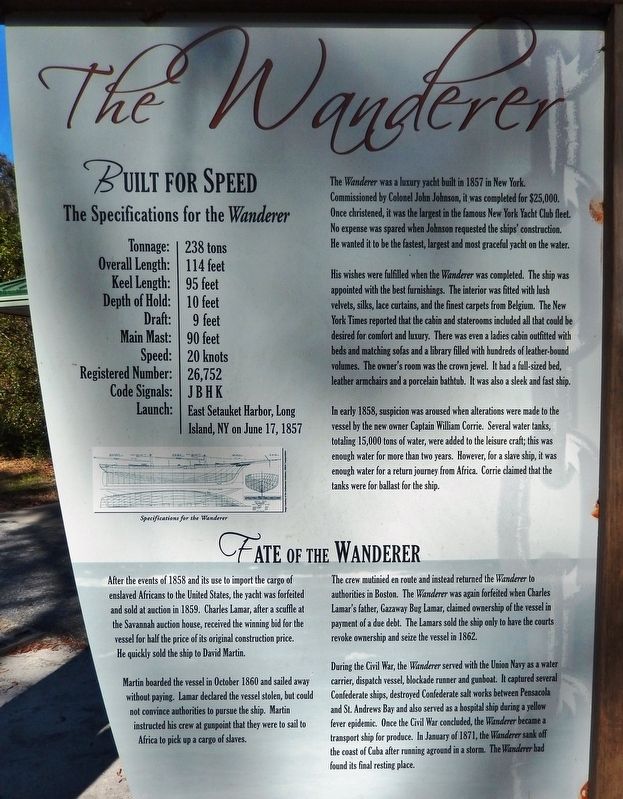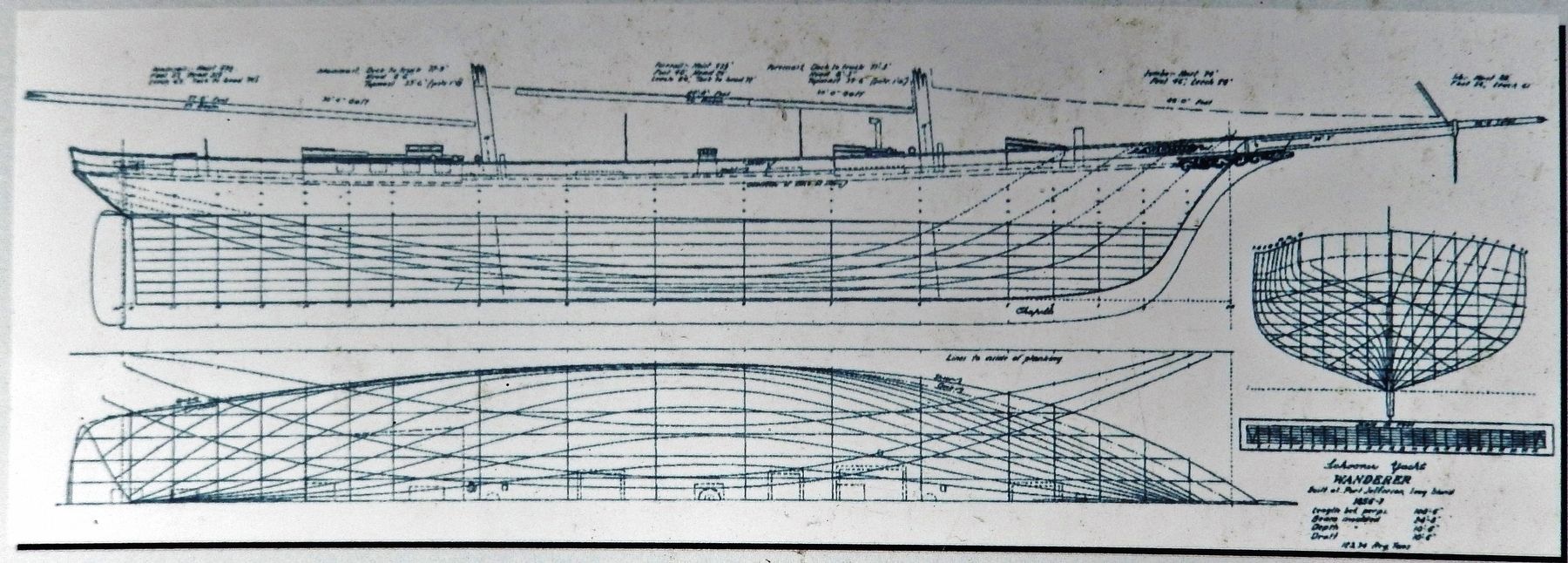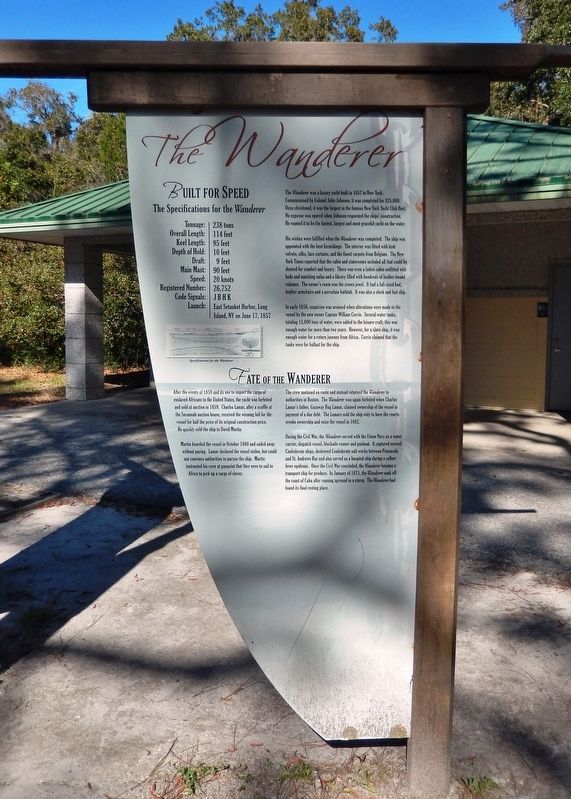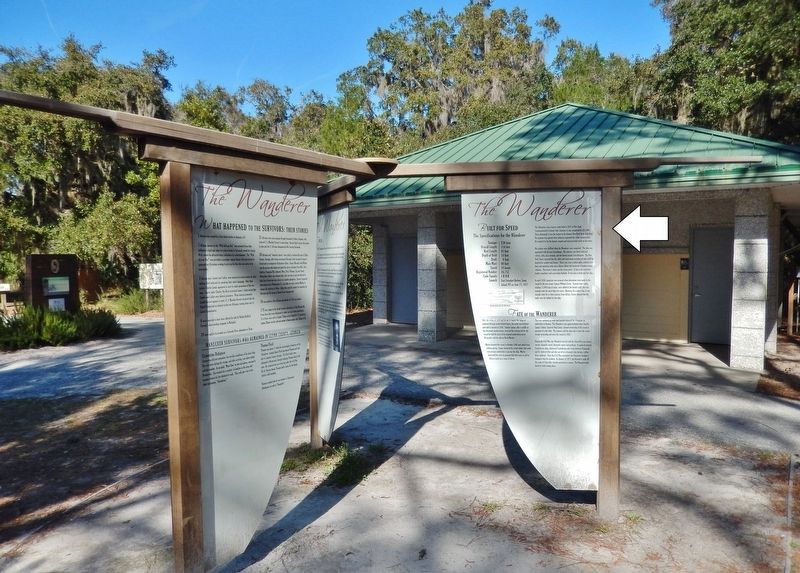Jekyll Island in Glynn County, Georgia — The American South (South Atlantic)
The Wanderer — Built For Speed
Tonnage: 238 tons
Overall Length: 114 feet
Keel Length: 95 feet
Depth of Hold: 10 feet
Draft: 9 feet
Main Mast: 90 feet
Speed: 20 knots
Registered Number: 26,752
Code Signals: JBHK
Launch: East Setauket Harbor, Long Island, NY on June 17, 1857
The Wanderer was a luxury yacht built in 1857 in New York. Commissioned by Colonel John Johnson, it was completed for $25,000. Once christened, it was the largest in the famous New York Yacht Club fleet. No expense was spared when Johnson requested the ships' construction. He wanted it to be the fastest, largest and most graceful yacht on the water.
His wishes were fulfilled when the Wanderer was completed. The ship was appointed with the best furnishings. The interior was fitted with lush velvets, silks, lace curtains, and the finest carpets from Belgium. The New York Times reported that the cabin and staterooms included all that could be desired for comfort and luxury. There was even a ladies cabin outfitted with beds and matching sofas and a library filled with hundreds of leather-bound volumes. The owner's room was the crown jewel. It had a full-sized bed, leather armchairs and a porcelain bathtub. It was also a sleek and fast ship.
In early 1858, suspicion was aroused when alterations were made to the vessel by the new owner Captain William Corrie. Several water tanks, totaling 15,000 tons of water, were added to the leisure craft; this was enough water for more than two years. However, for a slave ship, it was enough water for a return journey from Africa. Corrie claimed that the tanks were for ballast for the ship.
Fate of the Wanderer
After the events of 1858 and its use to import the cargo of enslaved Africans to the United States, the yacht was forfeited and sold at auction in 1859. Charles Lamar, after a scuffle at the Savannah auction house, received the winning bid for the vessel for half the price of its original construction price. He quickly sold the ship to David Martin.
Martin boarded the vessel in October 1860 and sailed away without paying. Lamar declared the vessel stolen, but could not convince authorities to pursue the ship. Martin instructed his crew at gunpoint that they were to sail to Africa to pick up a cargo of slaves.
The crew mutinied en route and instead returned the Wanderer to authorities in Boston. The Wanderer was again forfeited when Charles Lamar's father, Gazaway Bug Lamar, claimed ownership of the vessel in payment of a due debt. The Lamars sold the ship only to have the courts revoke ownership and seize the vessel in 1862.
During
the Civil War, the Wanderer served with the Union Navy as a water carrier, dispatch vessel, blockade runner and gunboat. It captured several Confederate ships, destroyed Confederate salt works between Pensacola and St. Andrews Bay and also served as a hospital ship during a yellow fever epidemic. Once the Civil War concluded, the Wanderer became a transport ship for produce. In January of 1871, the Wanderer sank off the coast of Cuba after running aground in a storm. The Wanderer had found its final resting place.
Erected by State of Georgia.
Topics. This historical marker is listed in these topic lists: African Americans • Industry & Commerce • War, US Civil • Waterways & Vessels. A significant historical date for this entry is June 17, 1857.
Location. 31° 1.284′ N, 81° 26.04′ W. Marker is on Jekyll Island, Georgia, in Glynn County. Marker can be reached from Beach View Drive, 0.1 miles north of South Riverview Drive. Marker is located in The Wanderer interpretive kiosk, just north of the parking lot at St. Andrews Beach Park. Touch for map. Marker is at or near this postal address: 1 South Riverview Drive, Jekyll Island GA 31527, United States of America. Touch for directions.
Other nearby markers. At least 8 other markers are within walking distance of this marker. The Wanderer — Arrival (here, next to this marker); The Wanderer — What Happened to the Survivors: Their Stories (here, next to this marker); The Wanderer — Cilucangy: Ward Lee (here, next to this marker); The Wanderer — Timeline: Continued (here, next to this marker); The Wanderer — Timeline (here, next to this marker); Wanderer Memory Trail (a few steps from this marker); Survivors of the Wanderer (a few steps from this marker); Taken From Africa (within shouting distance of this marker). Touch for a list and map of all markers in Jekyll Island.
Related markers. Click here for a list of markers that are related to this marker. Wanderer Memory Trail
Also see . . .
1. Wanderer. New Georgia Encyclopedia website entry:
Upon its completion, the Wanderer was considered to be one of the world's most impressive privately owned pleasure crafts. Of particular note was the ship's ability to achieve high speeds; its streamlined design allowed it to sail at a maximum of twenty knots per hour. (Submitted on March 12, 2021, by Cosmos Mariner of Cape Canaveral, Florida.)
2. USS Wanderer (1857). Wikipedia entry:
The first USS Wanderer was a high-speed schooner originally built for pleasure. It was used in 1858 to illegally import slaves from Africa. It was seized for service with the United States Navy during the American Civil War. In U.S. Navy service from 1861 to 1865, and under outright U.S. Navy ownership from 1863 to 1865, she was used by the Union Navy as a gunboat, as a tender, and as a hospital ship. (Submitted on March 12, 2021, by Cosmos Mariner of Cape Canaveral, Florida.)
Additional keywords. The Wanderer — Built For Speed
Credits. This page was last revised on April 6, 2024. It was originally submitted on March 12, 2021, by Cosmos Mariner of Cape Canaveral, Florida. This page has been viewed 301 times since then and 37 times this year. Photos: 1, 2, 3, 4. submitted on March 12, 2021, by Cosmos Mariner of Cape Canaveral, Florida.



